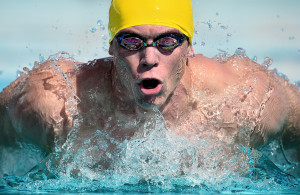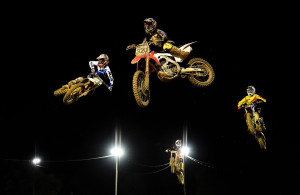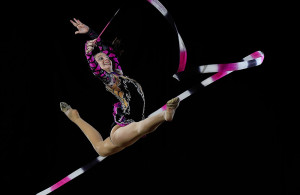
Hi and welcome to this edition of Workshop at the Ranch
(WATR.) This month I want to share with you a very special project I was recently involved with,
the sports image campaign for the NEW Nikon D4s. And let me begin by saying that the NEW features and improved performance of the D4s are significant…far more significant than any of us expected.
It has been my privilege and a great thrill to be asked by Nikon Japan to be a part of the NEW Nikon D4s promotional campaign. This was one of the largest and most logistically involved projects I have ever been involved with. The long process of making arrangements to secure multiple sports venues and more than a dozen athletes and their coaches began more than a month prior to the first day of shooting. The goal set before me was to put the New Nikon D4s through its paces and make sports action pictures for Nikon’s D4s promotional pieces.
These preparations would be for more than just my pictures showcasing the new and improved features of this most recent Flagship camera by Nikon. Also working on the D4s project would be famed photographer-videographer and good friend, Corey Rich.
Corey flew into our 8 day shooting schedule with his elite film crew and 16 cases of gear including a jib boom and drone helicopters. His assignment would be not only to showcase the video excellence of the NEW D4s camera, but produce a complete documentary film of the D4s project.
With all this pre-shoot preparation, gear, crew, athletes and locations, here are a few of my D4s images and my detailed commentary from what I believe to be the most IMPRESSIVE camera on the market today. Ladies and gentleman, allow me to introduce you to the NEW Nikon D4s.
The NEW D4s features and improvements over the D4 are significant: Auto Focus Accuracy, NEW Group Area AF, Increased Acceleration of the Auto Focus Tracking Speed, Higher ISO Sensitivity and Improved Noise Reduction at High ISO settings, jpg Image Quality Improvement, Reduced Blackout Time when shooting Continues Frames, Improved D Lighting and Active D Lighting modes, Improved Color rendition of Skin Tones, Additional Pre-Set White Balance settings, Increased Battery Life, 11 Frames Per Second, and more.
NOTE: My thanks to Nikon Japan for their permission to release these 4 images. These are the jpg fine files directly out of the D4s camera using the Picture Control setting of Standard. I have reduced them in size to fit my website image format to 10 in. x 6.5 in. at 100 dpi. No Photoshop has been added. I decided to display the images in this fashion to emphasize the greatly improved quality of the New D4s jpg FINE file. It is my opinion that photojournalist’s can easily publish the D4s jpg Fine file directly from the camera. The D4s jpg image quality is remarkable and one of the camera’s most notable improvements.

Image #1 Swimming… TEST: Auto Focus Accuracy and NEW Group Area AF… Nikon D4s, ISO500, 1/4000 at f5.6, Nikon AF-S 800mm f5.6 FL ED VR lens, WB Auto, Gitzo Carbon Fiber Monopod, SanDisk 64G Extreme Pro Flash Card.
Our first venue was swimming where we had some very high caliber athletes ready to race. The primary goal was to capture images with improved Auto Focus accuracy, both with Single Point and a NEW feature: Group Area AF.
“Awesome” is the word that comes to my mind when describing the significantly improved Auto Focus accuracy and Tracking Speed of the NEW D4s. I used a variety of long lenses throughout the entire project including the Nikon 800mm f5.6 lens wide open at f5.6.
I was greatly impressed with the immediate lock on of the Single Point Auto Focus as the Swimmer’s face advanced forward during the Butterfly stroke. But you’re probably thinking, “sure, that’s easy for you Dave, you’ve been shooting swimming for over 30 years…what about someone who is just beginning to shoot competitive swimming and other sports?
Point Taken… I know that for many photographers it can be challenging to keep a small single AF point on a fast moving-erratic subject, especially when the subject appears above the splashing water for only a split second.
I found that the Group Area AF with its 5 point AF Sensors arranged in a close group made it much easier for me, and I believe easier for anyone to lock on the AF to the swimmers face. And to be specific, the Group Area AF actually locked onto the swimmer’s goggles, even when I used a long lens like a 400mm f2.8 with TC14E 1.4x Teleconverter, a Nikon 600mm f4 also with the TC14E 1.4x, or in this picture the New Nikon 800mm wide open at f5.6.
Another improvement referred to as reduced “Blackout Time” is a huge help when shooting Continues Frames. The “Blackout Time” is the moment in between each consecutive frame where the subject is not visible through the viewfinder due to the camera’s mirror being in the down position. This reduced time in between frames (“Blackout Time”) makes it much easier to keep my eye on the subject and place the AF, either Single Point AF or the 5 sensor Group Area AF, exactly where I want it. In this case the swimmer’s goggles.
|

Image #2 Motocross… TEST: High ISO, Improved Noise Reduction, Auto ISO settings, and Auto WB accuracy… Nikon D4s, Auto ISO (ISO 20,000), 1/1600 at f2.8, Nikon 24-70mm f2.8 lens, WB Auto 1, SanDisk 64G Extreme Pro Flash Card.
With the Swimming phase of the D4s project complete and my excitement increasing with each picture I made, our production group moved to the next venue, Motocross. It was non-stop action, shooting and video filming for 12 hours straight. The athletes were that good and it was that much fun! Corey and I couldn’t help but notice that the battery life of the New D4s was yet another great improvement.
I shot with the complete range of Nikon lenses, from the Nikon 14-24mm to the Nikon 800mm and everything in between. I pushed the D4s through every mode possible and I even used SB-910 Speedlights with High-Speed Sync. My reaction agreed with Corey that this camera was truly something special whether shooting still imagery or video.
This image, “Cirque du Motocross” as I call it, was the final scenario shoot of a very long day. Our athletes had been racing all day and into the night. I wanted to know how clean was the High ISO under low lighting conditions and how accurate was the Auto ISO. But I also wanted to test the Auto white Balance under typical night sports low light and mixed color or lighting conditions.
This image was a favorite of mine and also the entire production crew. It was captured using Auto ISO and registered in at ISO 20,000. The file quality and edge detail looks amazing. The D4s Noise Reduction has been greatly, improved, and the Auto ISO setting was “spot on” regarding the exposure.
I also found the Auto WB settings to work very well when balancing the low light color mixture of lights at the motocross course. I seldom encounter venues that require this extreme ISO setting or color mix, but for those who cover High School sports indoors or outdoors under pathetic lighting conditions, this camera is for you.
This was a blind jump with the athletes coming towards at me at 45mph. Both AF features, Single Point AF and Group Area AF, performed perfectly even under the racetrack’s low lighting conditions that I believe were less than the typical HS football field.
When I shot 11 frame sequences at this jump I felt like a baseball player swinging for a home run while panning the camera as the 4 riders flew by me at such close range. I found that the Group Area AF made it easier for me to lock on the lead rider and track him from take off to landing.
I personally find it easier to place the Group Area AF group of 5 sensors on a fast erratic moving subject, especially when they are flying at you out of the dark sky. Each picture of the sequence was tack sharp, and with very accurate color with WB Auto 1. Keep in mind, this image is just the jpg out of the D4s camera…No Photoshop.
|

Image #3 Superbikes… TEST: Accelerated AF Tracking Speed with and Single and Group Area AF, and 11 fps Sequences with Improved Buffer Capabilities…Nikon D4s, ISO-1.0 (ISO 50), 1/8 at f18, Nikon 14-24mm lens f2.8 lens, WB 3030K, 4 Nikon SB-910 Speedlights (remote mode) and Nikon SU-800 Commander, FourSquare bracket by: Lightware Direct, SanDisk 64G Extreme Pro Flash Card, a Chevy Van with sliding side door and Corey’s climbing harness with safety rigging.
Superbike racing was the fastest subject of the Nikon D4s project. Both the Single Point AF and Group Area AF worked perfectly whether I used the 14-24mm at close range while laying down in the curve, or the 800mm lens on the straightaway. I made numerous 4 second bursts of 11 fps making final totals of 44 frames as each Superbike raced around various locations on the track.
I must say that the Single Point AF was so accurate that it picked up the riders helmet logo at great distance, and tracked it perfectly even with the 800mm lens as the racers accelerated towards me until the final image was just the riders helmet logo and face shield. Never once did the focus shift to the shoulder or front faring of the Superbike.
This picture is simply a personal favorite from the Superbike shot. Motorcycle racecourses restrict heavier vehicles from driving because the additional weight can damage the racing surface. We secured special permission to have one of Corey’s production vans keep pace along side two of our racers for a few fast runs up the main straightaway.
This would be a great opportunity to do some Slow Shutter Speed Panning with Rear Curtain Speedlight work. And for those who know me I instinctively went to my favorite “Moody Blue” lighting formula by using Nikon’s full CTO Warming Gels (filters) over each SB-910 and changing the camera’s White Balance to 3030K (Kelvin).
The result is a stylized image of our Superbikes racing while I shoot at a very slow 1/8 of a second shutter speed. My 4 Nikon SB-910 Speedlights are mounted to my FourSquare bracket positioned out the front passenger window by my assistant, Julio Aguilar, and aimed back towards the racers.
I’m sitting on the van floor and leaning out the open side door with my D4s and Nikon 14-24mm lens. Corey always travels with his climbing gear and suggested that I should be harnessed to the van’s bench seat so I could hang farther out the door. Count me in, now we’re talking a real thrill !
Hanging farther out the door and holding the camera steady while fighting the 60mph+ wind and rain was a challenge that I thought would make it difficult to keep to keep the focus point on my subject, but the Group Area AF made the task easy.
|

Image #4 Rythmic Gymnastics…TEST: Improved High ISO Noise Reduction, AF Accuracy in Low Light and Continuos Sequential Frames vs. Buffer Capacity … Nikon D4s, ISO3200, 1/1600 at f4.5, Nikon 70-200mm G VRII lens, WB Auto, SanDisk 64G Extreme Pro Flash Card.
Rythmic Gymnastics is a beautiful but difficult sport to photograph, especially for those who are unfamiliar with it. Athletes’ routines are full of leaps, jumps, dance with ribbons, hoops, and all this flying every which way within the 40 ft. x 40 ft. carpeted competition area and in low lighting conditions.
But that wasn’t enough challenge for this final phase of my participation with the Nikon D4s project. I chose to further put the new camera’s AF system to the test by draping the Rythmic gymnasium with black cloth and having my athlete wear a black leotard.
Perhaps this insane decision of unpredictable erratic action, low light conditions and black backdrop came from the fact that I had been shooting round the clock for a full week. My eyes and brain were growing a bit weary, but I was brimming with confidence thanks to the NEW Nikon D4s camera.
With this difficult TEST scenario explained, I’m about to use a phrase that I don’t think I have ever used when teaching photography. Thanks to the Group Area AF “I couldn’t miss.” Yes, you heard me correct, “I couldn’t miss.”
There is confidence factor that increases when using the Group Area AF. It makes locking on to the moving athlete very easy. This greater ease regarding placement of the 5 AF sensors that make up the Group Area AF feature and the Reduced Blackout Time that I mentioned earlier add up to greater and nearly instant success regarding sports action imagery.
The D4s performed amazingly throughout the Rythmic Gymnastics shoot. Nearly noiseless at ISO3200 and ISO6400, with beautiful Healthy Skin Tones, faster AF Tracking Speed, and jpg Quality so good that you can publish it straight out of the camera.
And here’s another significant improvement; I can now shoot continuos framing sequences of 44 RAW+jpg 12 bit uncompressed files. That’s a 4 second burst at 11 frames per second…AMAZING! |
Well, this was a great adventure for me, and a long 2,444 word WATR for all of you. I hope you have all enjoyed my review of the NEW Nikon D4s camera.
I’m not a camera technician and did not write this article as a technical review. Rather, I offer my “field experience” with the NEW Nikon D4s camera as my personal testimony as to what this camera can do to help me and others capture great sports imagery.
My thanks to Nikon Japan for this very special opportunity to work with the NEW Nikon D4s camera, and to Atsushi Horiuchi for his valuable technical assistance on location, and to Lindsay Silverman from Nikon USA for his contributing expertise.
Many thanks also to my friend and colleague Corey Rich and his video crew for being so easy and fun to work with during this entire project. Every day and every venue was a joy and a great experience for me to work with Corey and his team.
And my personal thanks to Gen Umie from K&L Japan for being a great project director, team leader, and good friend.
See you next month here at Workshop at the Ranch where I will resume answering your questions. Adios. Dave
 Hi and welcome to this edition of Workshop at the Ranch (WATR.) This month I want to share with you a very special project I was recently involved with, the sports image campaign for the NEW Nikon D4s. And let me begin by saying that the NEW features and improved performance of the D4s are significant…far more significant than any of us expected.
Hi and welcome to this edition of Workshop at the Ranch (WATR.) This month I want to share with you a very special project I was recently involved with, the sports image campaign for the NEW Nikon D4s. And let me begin by saying that the NEW features and improved performance of the D4s are significant…far more significant than any of us expected.




